Seasons Greetings
As many of you know I don't send Christmas cards, instead I give the monies I would have spent to MS Research. Have a great time and a successful New Year,

Seasons Greetings
As many of you know I don't send Christmas cards, instead I give the monies I would have spent to MS Research. Have a great time and a successful New Year,

Seasons Greetings
I hope you all have a great seasonal holiday, it has been a tough few years for folks so I think everyone needs a break. As Bad Company sang in Wishing Well.
But I know what you're wishing for, Love in a peaceful world
As in previous years rather post cards to everyone, instead any monies saved have been donated to the Multiple Sclerosis Society.

Target Validation
A couple of minor updates to the Target Validation page.
https://www.cambridgemedchemconsulting.com/resources/targetvalidation.html
Annual site review
The Drug Discovery Resources website continues to be very popular with 161,922 page views. The pages were visited by over 76,200 viewers and around 20% of the visitors come back on multiple occasions suggesting they find it useful. The visitors come from 180 different countries with the top countries being
- United States (27%)
- United Kingdom (14%)
- India (10%)
- Germany (4%)
- South Korea (3%)
- China (3%)
One of the popular pages in 2021 was COVID-19 and the Identification of "Drug Candidates" a checklist for those using virtual screening to identify potential hits for COVID-19 targets. This has dropped out of the top pages in 2022.
The other most viewed pages were
- Lipophilicity
- Bioisosteres
- Molecular Interactions
- Distribution and Plasma Protein Binding
- Kinase Inhibitors
- Acid Bioisosteres
- ADME
- Aromatic Bioisosteres
- Aspartic Acid Proteases
- Solvation and desolvation
- HERG Activity
- Fragment based screening
Looking at the operating systems 54% are Windows users, 20% Mac users, 12% Android, 10% iOS and 2% Linux. The browsers of choice are Chrome and Safari with all other below 10%.
I don't know how comprehensive the analytics software is but there is approximately a 54:46 M:F split for Gender.
Seasons Greetings
Hoping everyone has a safe Christmas break.
As always I won't be sending cards but instead donate the money to the MS Society (https://www.mssociety.org.uk).
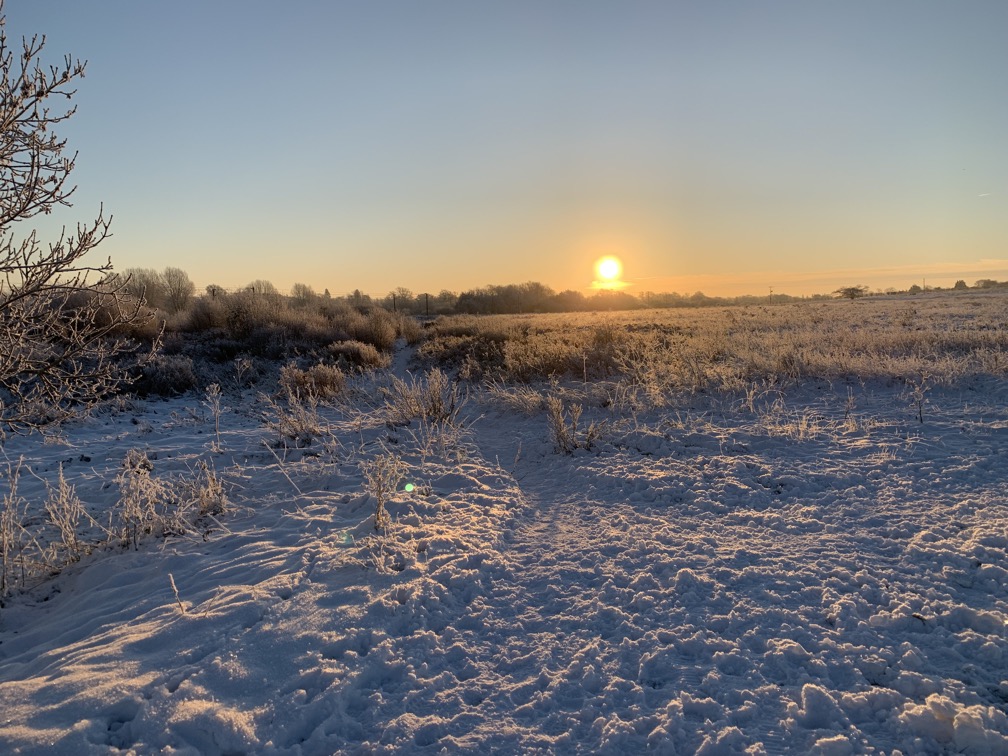
Annual site review
As 2022 starts I'd like to wish you all a Happy New Year and hope that 2022 marks the start of the recovery from the pandemic.
The Drug Discovery Resources website continues to increase in popularity with 193,322 page views, an increase of 31% over the figure for 2020. The pages were visited by over 95,308 viewers and around 20% of the visitors come back on multiple occasions suggesting they find it useful. The visitors come from 180 different countries with the top countries being
- United States (25%)
- United Kingdom (14%)
- India (13%)
- Germany (3.6%)
- Canada (3%)
- South Korea (2.5%)
Perhaps not unexpectedly one of the popular pages was COVID-19 and the Identification of "Drug Candidates" a checklist for those using virtual screening to identify potential hits for COVID-19 targets.
The other most viewed pages were
- Lipophilicity
- Bioisosteres
- Distribution and Plasma Protein Binding
- Molecular Interactions
- Kinase Inhibitors
- Acid Bioisosteres
- Aromatic Bioisosteres
- Aspartic Acid Proteases
- Solvation and desolvation
- HERG Activity
- Fragment based screening
- ADME
Looking at the operating systems 54% are Windows users, 20% Mac users, 13% Android, 9% iOS and 2% Linux.
I don't know how comprehensive the analytics software is but there is approximately a 50:50 M:F split for Gender.
Seasons Greetings
It has been a mild winter here so far but some lovely still mornings. Take care everyone and have a great break and a successful New Year. As ever monies saved on cards will be donated to the MS Society. https://www.mssociety.org.uk.

Annual Site Review
As 2021 starts I'd like to wish you all a Happy New Year and hope that 2021 marks the start of the recovery.
The Drug Discovery Resources website continues to increase in popularity with 147,000 page views, an increase of 5% over the figure for 2019. The pages were visited by over 76,000 viewers and around 20% of the visitors come back on multiple occasions suggesting they find it useful. The visitors come from 177 different countries with the top countries being
- United States (28%)
- United Kingdom (14%)
- India (10%)
- Germany (3%)
- Canada (3%)
- Japan (2.5%)
Perhaps not unexpectedly one of the popular pages was COVID-19 and the Identification of "Drug Candidates" a checklist for those using virtual screening to identify potential hits for COVID-19 targets.
The other most viewed pages were
- Lipophilicity
- Calculating Physicochemical Properties
- Bioisosteres
- Distribution and Plasma Protein Binding
- Molecular Interactions
- Kinase Inhibitors
- Acid Bioisosteres
- Aromatic Bioisosteres
- Aspartic Acid Proteases
- Solvation and desolvation
- HERG Activity
- Fragment based screening
- Protacs
Looking at the operating systems 54% are Windows users, 20% Mac users, 12% Android, 10% iOS and 2% Linux.
Seasons Greetings
This has been a tough year for everyone but we still need to think about those less fortunate, as usual any monies saved on cards will be donated to the MS Society. Have a safe break and let's hope for better things in 2021.
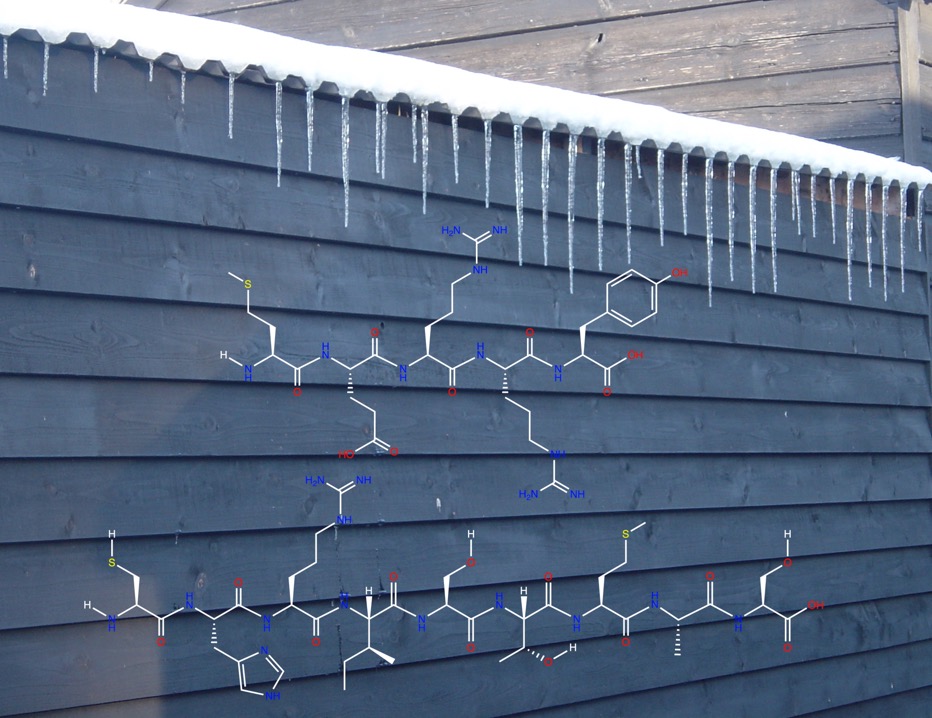
Drug Discovery Resources Website Stats
I wrote a blog entry about things that should be considered when proposing a hit identified from virtual screening as a drug candidate. Several people have suggested I create an easily identifiable web page so they can reference it. So here it is
COVID-19 and the Identification of "Drug Candidates".
I also thought I'd use the opportunity to look at the Drug Discovery Resources website stats for the first 6 months of 2020.
The Drug Discovery Resources pages are intended to act as a resource for scientists undertaking drug discovery, they were initially based on a course I give but have been expanded to give much more detail and to cover subjects not covered in the course.
The site has been viewed by almost 40,000 viewers with most people viewing a couple of pages per session. The viewers come from over 150 countries, the top countries being.
- United States (28%)
- United Kingdom (16%)
- India (9%)
- Germany (3.5%)
- China (3%)
- Canada (3%)
- Japan (3%)
The most viewed pages were
- Lipophilicity
- Calculating Physicochemical Properties
- Bioisosteres
- Distribution and Plasma Protein Binding
- Molecular Interactions
- Kinase Inhibitors
- Acid Bioisosteres
- Aromatic Bioisosteres
- Aspartic Acid Proteases
- Solvation and desolvation
- Formulation
- Fragment based screening
- Protacs
Looking at the operating systems 55% are Windows users, 20% Mac users, 12% iOS and 12% Android, Chrome dominates the browser stats (64%) with Safari second (17%) and Firefox third (7%).
Seasons Greetings
Have a great time and a successful New Year, it's a beautiful world let's make sure it is still there for future generations.

As usual any monies saved on cards will be donated to the MS Society
ADME pages updated
I've spent a while updating the ADME section of the Drug Discovery Resources. I particular I've added a little on the Developability score DOI that identifies four distinct cLog P/molecular weight regions that define optimal and sub-optimal chemical space. I've also added a couple of useful references.
In addition, I've expanded the Absorption and Bioavailability page to include more on bioavailability with links to physicochemical properties. The Distribution and Plasma Protein Binding section has a couple of extra examples demonstrating the impact plasma protein binding has on other pharmacokinetic properties. I've added a few details of in vitro assays to the Transporters page, and expanded the in silico brain penetration models section.
The section on Aldehyde oxidase has been greatly expanded and now includes a section on prediction and mitigation, and added useful references.
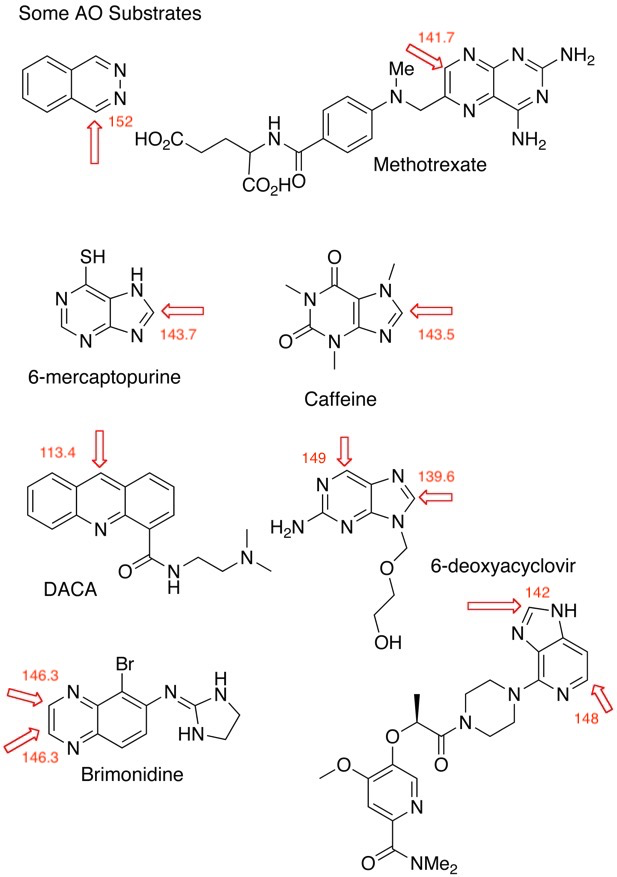
Drug Discovery Resources
Just checking the half-year viewing stats for the Drug Discovery Resources section of the website.
The Drug Discovery Resources pages are intended to act as a resource for scientists undertaking drug discovery, they were initially based on a course I give but have been expanded to give much more detail and to cover subjects not covered in the course.
Over the first six months there were nearly 35,000 users with users on average viewing 2-3 pages. The visitors come from 152 different countries with the US (33%), UK (14%) , India (8%), Germany (3.2%) and Canada (3.1%) topping the list.
The most viewed pages over this period were
- Lipophilicity
- Calculating Physicochemical Properties
- Distribution and Plasma Protein Binding
- Bioisosteres
- Molecular Interactions
- Kinase Inhibitors
- Acid Bioisosteres
- Aromatic Bioisosteres
- Solvation and desolvation
- Aspartic Acid Proteases
- CYP Interactions
- Fragment based screening
- HERG
Looking at the operating systems 56% are Windows users, 20% Mac users, 10% iOS and 10% Android, Chrome dominates the browser stats (65%) with Safari second (17%) and Firefox third (10%).
Updated Drug Discovery Resources
I've done some updates to the Drug Discovery Resources.
The Following Pages have been Updated
Macrocycles
Predicting Metabolism
Covalent Inhibitors
PROteolysis TArgeting Chimeras (PROTACs), Lysosome Targeting Chimeras (LYTACs), and ENDosome TArgeting Chimeras (ENDTACs)
Website Update
I've spent some time over the last couple of weeks updating and adding new content to the Drug Discovery Resources section of the website.
In particular, s drug targets become more challenging medicinal chemists are looking at alternatives to small molecule competitive inhibitors, the section on covalent inhibitors have been expanded and a new page on PROTACs has been added. PROTACs are bifunctional molecules that bind to the target protein and an E3 ligase, the simultaneous PROTAC binding of two proteins brings the target protein in close enough proximity for polyubiquitination by the E2 enzyme associated to the E3 ligase, which flags the target protein for degradation through the proteasome. This offers a powerful alternative to competitive inhibition.
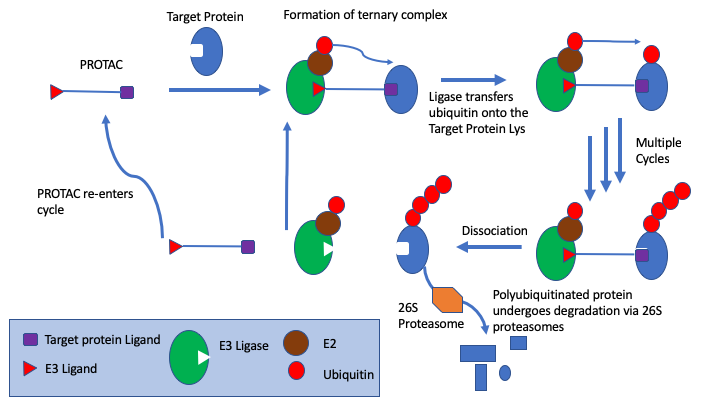
The Probes & Drugs portal has been added to the chemical probes page, this is a public resource joining together focused libraries of bioactive compounds (probes, drugs, specific inhibitor sets etc.) with commercially available screening libraries.
The page describing commercial fragment screening libraries has been updated to include a couple of new additions and flagging some that seem to be unavailable, if I've missed any feel free to let me know.
The section on hERG has been updated with links to new references and details of hERGcentral.
hERGCentral: A Large Database to Store, Retrieve, and Analyze Compound-Human Ether-à-go-go Related Gene Channel Interactions to Facilitate Cardiotoxicity Assessment in Drug Development. The hERGCentral database hergcentral.org is based on experimental data obtained from a primary screen by electrophysiology against more than 300,000 structurally diverse compounds screened at 1 and 10uM.
Unfortunately the database appears to be no longer available. Whilst the supplementary information for the original publication does not contain the structures of the tested compounds it does reference the PubChem substance ID. I used these identifiers to download the structures of the >300,000 records and combined them with the experimental data provided in the Excel tables in the supplementary information. The complete dataset can be downloaded from the hERG page.
Small molecules can potentially bind to a variety of bimolecular targets and whilst counter-screening against a wide variety of targets is feasible it can be rather expensive and probably only realistic for when a compound has been identified as of particular interest. For this reason there is considerable interest in building computational models to predict potential interactions the page on predicting bioactivities has been expanded.
The section on bioisosteres also have a few new examples.
Annual Website Review
As 2019 starts I'd like to wish you all a Happy New Year and hope for great success in your drug discovery endeavours.
The Drug Discovery Resources website continues to increase in popularity with over 147,000 page views, an increase of 8% over the figure for 2017. The pages were visited by over 72,500 viewers and around a third of the visitors come back on multiple occasions suggesting they find it useful. The visitors come from 172 different countries with the US (32%), UK (13%) and India (8%) topping the list.
The most viewed pages in 2018 were
- Lipophilicity
- Distribution and Plasma Protein Binding
- Bioisosteres
- Calculating Physicochemical Properties
- Molecular Interactions
- Kinase Inhibitors
- Aspartic Acid Protease Inhibitors
- Solvation and desolvation
- Hit Identification
- CYP Interactions
- Acid Bioisosteres
- Fragment based screening
- HERG
There have been a number of significant updates to the Drug Discovery Resources this year, in particular, a new section on Macrocycles which has proved very popular. The Target Validation section has been updated several times, as has the Molecular Interactions page and I'm grateful for readers who have pointed out relevant recent publications.
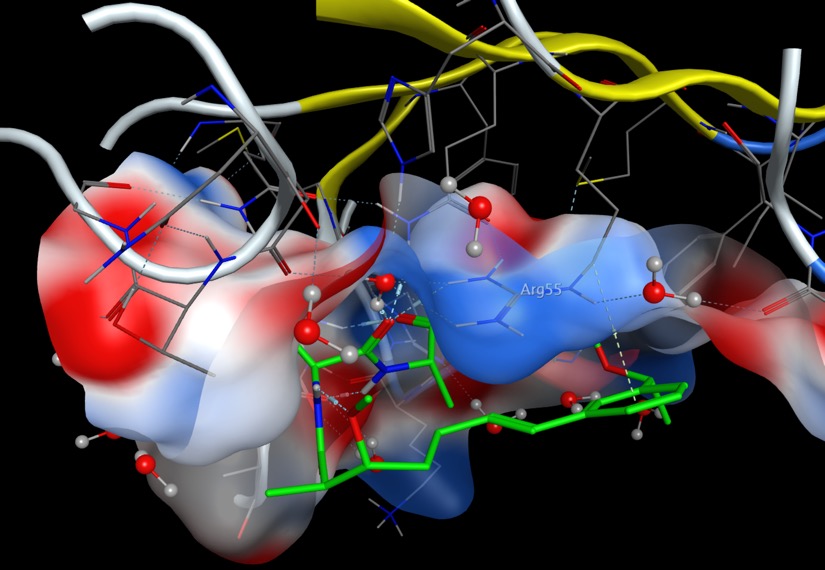
Interestingly the Books and Grant funding research have seasonal peaks in viewing.
Looking at the operating systems 56% are Windows users, 20% Mac users, 10% iOS and 10% Android, Chrome dominates the browser stats (64%) with Safari second (17%) and Firefox third (10%).
Seasons Greetings

As in previous years all monies saved for not sending greetings cards will be given to the Multiple Sclerosis Society.
Drug Discovery Resources Updated
I've spent a little time updating the Drug Discovery Resources Section of the website. In particular:
- CYP interactions now includes details of published crystal structures and more information on known inhibitors
- I've added page on CYP1A2 from ChEMBL data and updated the CYP2D6 and CYP3A4 pages
- Updated the page on Aldehyde Oxidase
- Added new examples on the bioisosteres page
- Updated the Published Fragments section, including adding the overlay of all examples of Kinase fragment hits from the PDB.
- Added new examples to the Chemical Probes page
- Included more examples of halogen bonding to the Molecular Interactions page
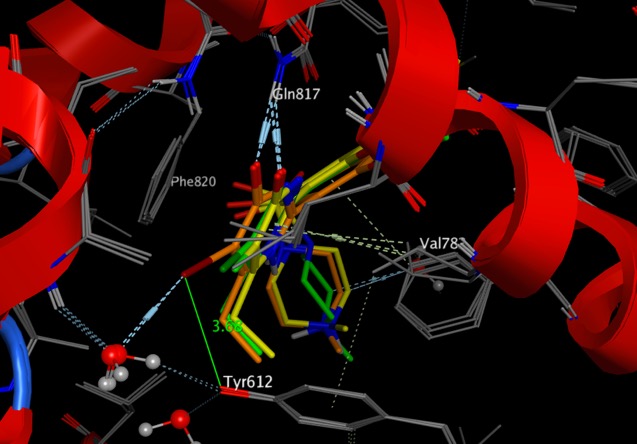
Molecular Interactions page updated
The Molecular Interactions page has been updated to include a section on anion-aryl interactions.
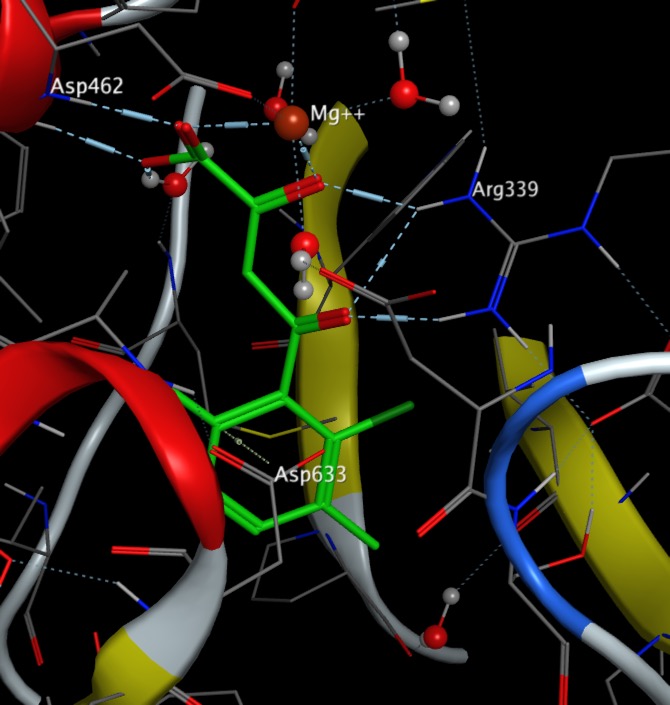
Website Update
A couple of people have asked me how to access the category tags that are attached to news items, the short answer is not easily so I've created a new tab at the top of the page that gives you direct access.
Click on the link and you will get an alphabetical listing of all categories with appropriate links.
It may take a day or so for the new menu bar to appear on all pages.
Annual Review of website
The Drug Discovery Resources website continues to increase in popularity with over 137,000 page views, an increase of 27% over the figure for 2016. The pages were visited by over 71,000 viewers and around a quarter of the visitors come back on multiple occasions suggesting they find it useful. The visitors come from 177 different countries with the US (31%) and UK (15%) topping the list.
The most viewed pages in 2017 were
- Distribution and Plasma Protein Binding
- Lipophilicity
- Calculating Physicochemical Properties
- Molecular Interactions
- Bioisosteres
- Molecular Interactions
- Solvation and desolvation
- Formulation
- Kinase Inhibitors
- Acid Bioisosteres
- Fragment based screening
- Aspartic Acid Protease Inhibitors
- HERG
- CYP Interactions
There have been a number of significant updates to the Drug Discovery Resources this year, in particular Target Validation has been expanded and the section on Chemical Probes given a separate page, highlighting invaluable resources like Probe Miner. Another new addition to the site has been the page on Covalent Inhibitors I got a significant amount of feedback on this page and it was updated several times.
I posted a poll on the website asking how many molecules are usually selected from a virtual screening run?
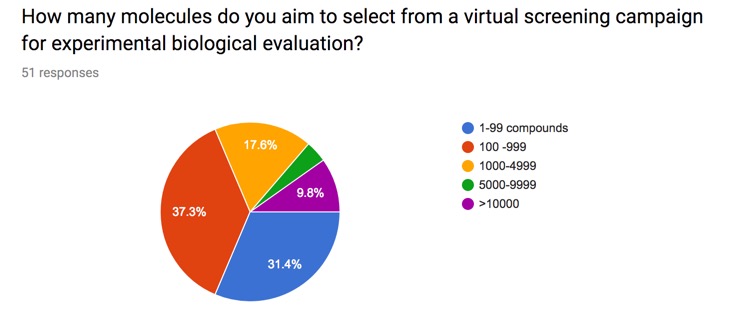
Some people also emailed me with further information. For companies with large internal physical screening collections, and the ability to cherry pick samples, it effectively costs the same to fill a high density plate (>1000 compounds) as it does to select a handful of compounds. On the other hand if the scientist has to purchase compounds then the logistics and cost become a significant obstacle.
There have been a couple of publications this year describing problems arising from analysis of high-throughput screening data, I've updated the Analysis of high-throughput screening data page to try and highlight some of the issues and strategies.
One of the highlights of the year for me was the 19th RSC / SCI Medicinal Chemistry Symposium (#19thCamMedChem) which took place 10th-13th September 2017 at Churchill College, Cambridge, UK. In particular a session on Neglected and Tropical Diseases, to increase the exposure of the brilliant science undertaken in this important therapeutic area the conference organisers arranged for this to be a live webinar. The session was also recorded and is now available online.
This is a recording of the Neglected and Tropical Diseases Session at the 19th Cambridge MedChem Meeting, 11-13 September 2017. The speakers are Kelly Chibale (Univ of Capetown), Christoph Boss (Actelion), Rob Young (GlaxoSmithKline), Jonathan Large (LifeArc) and Charles Mowbray (DNDI). To date this has been watched nearly 250 times.
Please feel free to share. #19thCamMedChem.
The European Lead Factory (ELF) is a collaborative public-private partnership aiming to deliver novel lead molecules for drug discovery programs. When the consortium was formed around 5 years ago there was a lot of scepticism about whether a group of 30 partners rating from large Pharma companies to small academic groups could ever agree on a legal framework that would allow the ELF to function. In a addition, in an industry where confidentiality was critical to maintaining intellectual property the idea that a group of large Pharma companies would share their sample collections often regarded as the "Crown Jewels" seemed impossible. However I was at the European Lead factory Stakeholder Meeting (24-25 April 2017) and it is clear that is has been a success and I've written a summary here.
Interestingly the Books and Grant funding research have seasonal peaks in viewing.
The website was also updated this year to use https rather than http, this involved editing a fair number of of hardcoded URLs. Whilst I don't require any secure transactions it does seem that https offers a level of trust that is beneficial. It seems likely that other web browsers will follow Google's lead and have a popup message when accessing any page using http, I suspect this could rapidly become irritating so I've decided to make the move. You will still able to access using http but I'll be setting up redirects later this week. Hopefully the visitors will not really notice any difference.
Looking at the operating systems 52% are Windows users, 21% Mac users, 10% iOS and 9% Android, Chrome dominates the browser stats (62%) with Safari second (20%) and Firefox third (12%).
Seasons Greetings

Clare College view of bridge from Old Court
As in previous years all monies saved for not sending greetings cards will be given to the Multiple Sclerosis Society
Causes of death over 100 years
The UK Office of National Statistics has produced a fascinating interactive plot of the causes of death in the UK over the last 100 years.
I've captured a screenshot of the plots but I'd urge to go and have a look at the interactive plot on the website http://visual.ons.gov.uk/causes-of-death-over-100-years/.
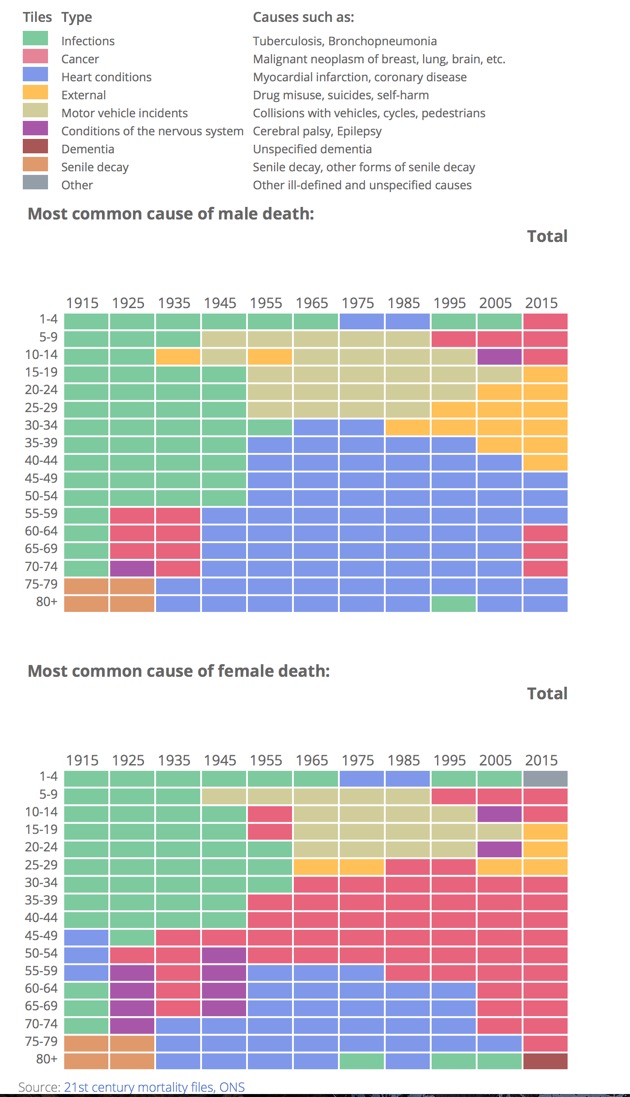
What is very apparent is the impact the introduction of antibiotics had in the late 1940's, and the introduction of mass vaccinations, deaths due to infections have been virtually eliminated.
In men heart disease remains the major killer whilst in women it is breast cancer. Sadly among the young it looks like mental health issues are a major concern.
Website update
I've spent the weekend updating the website to use https rather than http, this involved editing a fair number of of hardcoded URLs. Whilst I don't require any secure transactions it does seem that https offers a level of trust that is beneficial. It seems likely that other web browsers will follow Google's lead and have a popup message when accessing any page using http, I suspect this could rapidly become irritating so I've decided to make the move. You will still able to access using http but I'll be setting up redirects later this week. Hopefully the visitors will not really notice any difference.

If you want to edit your bookmarks here is the new link https://www.cambridgemedchemconsulting.com
Drug Discovery Resources Site Update
I've completed a few updates to the Drug Discovery Resources website, this includes fixing any broken links that people have mentioned to me, and also starting a new section in the Pre-clinical toxicity on Mutagenicity.
Annual Site review
As 2016 ends I'd like to take the chance to wish you all a Happy New Year and hope for great success in your drug discovery endeavours.
This website continues to increase in popularity with over 108,000 page views, an increase of 16% over the figure for 2015. The pages were visited by over 50,000 viewers and around a quarter of the visitors come back on multiple occasions suggesting they find it useful. The visitors come from 160 different countries with the US and UK topping the list.
The most viewed pages were
- Distribution and Plasma Protein Binding
- Calculating Physicochemical Properties
- Molecular Interactions
- Bioisosteres
- Lipophilicity
- Solvation and desolvation
- Formulation
- Fragment based screening
- Aspartic Acid Protease Inhibitors
- HERG
- CYP Interactions
Interestingly the Books and Grant funding research have seasonal peaks in viewing.
Looking at the operating systems 57% are Windows users, 22% Mac users, 10% iOS and 8% Android, Chrome dominates the browser stats (58%) with Safari second (20%) and Firefox third (15%).
Seasons Greetings
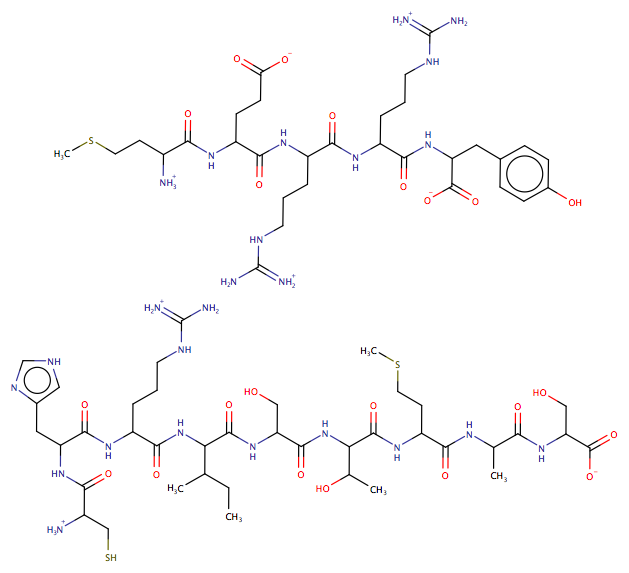
As in previous years all monies saved for not sending greetings cards will be given to the Multiple Sclerosis Society
Web browsers used in Drug Discovery
Last week I posted this observation
More and more of the companies/groups that I'm working with are moving away from desktop applications to providing a web-based portfolio of applications for drug discovery. Most seem to use a combination of commercial tools with a selection of in house apps. Whilst this has many advantages it does raise the question about which web browser should they support? Whilst NetMarketshare still has Internet Explorer at 44% this is probably not a good metric to measure browser usage in the Drug Discovery Sector. So for the last couple of months I've been monitoring the web browsers used to access the Drug Discovery Resources since it is unlikely that anyone not interested in drug discovery would spend much time browsing these pages. The results are interesting.
The ranking since 1 Jan 2016 to date is
- Chrome 55%
- Safari 20%
- Firefox 16%
- Internet Explorer 4%
Looking at operating systems
- Windows 57%
- Macintosh 23%
- iOS 11%
- Android 8%
So the lack users of Internet Explorer is not due to the absence of Windows users. This must have implications for all developers, the users appeared to have moved to the more modern web browsers.
Update
I've now data from around 10 different sites involved in drug discovery or software/databases to support drug discovery, ranging from small sites with about 10,000 hits a month to major sites with many millions of hits a month, and I've now included the average data in the table below.
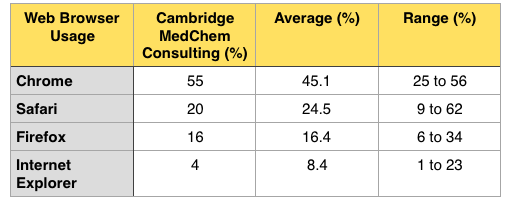
It looks like the data from Drug Discovery Resources reasonably reflects the usage in the Drug Discovery sector.
Web-based tools
More and more of the companies/groups that I'm working with are moving away from desktop applications to providing a web-based portfolio of applications for drug discovery. Most seem to use a combination of commercial tools with a selection of in house apps. Whilst this has many advantages it does raise the question about which web browser should they support? Whilst NetMarketshare still has Internet Explorer at 44% this is probably not a good metric to measure browser usage in the Drug Discovery Sector.
So for the last couple of months I've been monitoring the web browsers used to access the Drug Discovery Resources since it is unlikely that anyone not interested in drug discovery would spend much time browsing these pages. The results are interesting.
The ranking since 1 Jan 2016 to date is
- Chrome 56%
- Safari 20%
- Firefox 16%
- Internet Explorer 4%
Looking at operating systems
- Windows 57%
- Macintosh 23%
- iOS 11%
- Android 8%
So the lack users of Internet Explorer is not due to the absence of Windows users. This must have implications for all developers, the users appeared to have moved to the more modern web browsers.
Update
A number of readers/companies have contacted me since I published with broadly similar results, I hope to compile and publish the anonymised results next week.
Annual Site Review
As 2015 ends I'd like to take the chance to wish you all a Happy New Year and hope for great success in your drug discovery endeavours.
The website increases in popularity with 93,000 page views in 2015 an increase of 24% over last year. Nearly 25% of the visitors come back on multiple occasions which I hope means people are finding the content useful.
Nine of the top ten most popular pages were from the Drug Discovery Resources Pages which I am delighted to see, since it suggests that the work entailed in putting the resources together is worthwhile.
The most viewed pages were
- Distribution and Plasma Protein Binding
- Calculating Physicochemical Properties
- Molecular Interactions
- Lipophilicity
- Formulation
- Bioisosteres
- Fragment based screening
- Aspartic Acid Protease Inhibitors
- Serine Protease Inhibitors
As might be expected the Books page only seems popular coming up to Christmas ;-)
The visitors come from over 100 different countries with US and UK topping the list. Whilst desktop systems predominate nearly 20% now access the site from a mobile device.
Annual Site Review
At the end of each year I take the opportunity to look at the website analytics to see what parts of the website are the most popular. Overall there was a 15% increase in the number of page views up to 75,000. Average time on a page was 2 mins suggesting the content is engaging with the viewers.
Nine of the top ten most popular pages were from the Drug Discovery Resources Pages which I am delighted to see, since it suggests that the work entailed in putting the resources together is worthwhile.
The most viewed pages were
Drug Discovery Resources website updated
I’m in the process of updating the Drug Discovery Resources pages, in particular I’ve updated the Grant Funding resources and Fragment screening.
Drug Discovery Resources website annual report
The Drug Discovery Resources section of the website is intended to act as a resource for scientists undertaking drug discovery, it was originally simply a web page version of a course I used to give but has been continuously expanded and updated. Since this takes a far amount of time I like to monitor usage to check that it is being used.
In 2013 the Drug Discovery Resources section was viewed by nearly 24,000 unique visitors (there were 9000 unique visitors in 2012), 27% of which made more than one visit. There were 65,000 page views and on average visitors viewed two pages per visit. There were visitors from 141 different countries with the US and UK being the most common.
The most frequently accessed pages were
Drug Discovery Resources
Plasma Protein Binding and Distribution
Molecular Interactions
Formulation
Fragment Screening
The most popular sections were
ADME
Bioisosteres
Hit Identification
The top search queries were
Plasma Protein Binding
LogD
Bioisosteres
ADME
Aldehyde Oxidase
Website Update
I’ve now finished updating the website. I’ve changed the host, redesigned the theme and updated almost every page.
Feel free to have a look around and let me know of any issues or suggestios.
